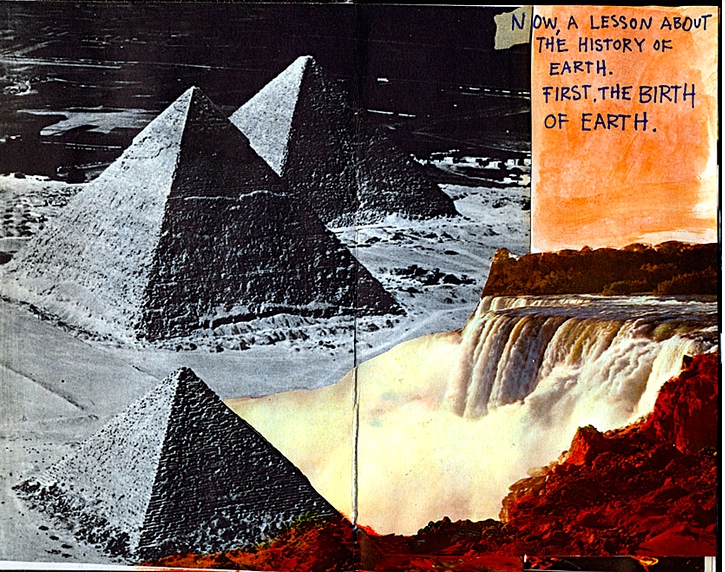I Don’t Keep a Journal the Way Most Journal Artists Do • A Conversation with Brian Singer of 1000 Journals Projects
Bretty Rawson
Brian Singer is a San Francisco-based fine artist whose sobriquet “Someguy” downplays the enormously unique body of work he has produced in the last decade or so. I first discovered his work at age 15, when I stumbled across the 1000 Journals Project book in my sister’s bedroom.
An ongoing collaborative experiment, The 1000 Journals Project attempts to track 1000 originally empty journals through their travels across the globe, accumulating stories, sketches, and photographs as they pass between friends’ and strangers’ hands. In addition to larger scale projects such as this, he creates visual art pieces that explore the layers of signification of the printed word, crossing out and redacting text in a process of mixed media décollage.
SARAH MADGES: The extensive, anonymous shared artifact network you created with The 1000 Journals Project speaks volumes about individuals' desires to be creative, without fear of criticism. Did you expect to find so many untapped talents waiting to give expression to their thoughts? Did you initially conceive of this project as a way to make collaborative art or did it just kind of happen?
BRIAN "SOMEGUY" SINGER: I think everyone is creative, but society tends to have a narrow definition of the word. Some people are creative when they cook, or garden, others make art. In the book Orbiting the Giant Hairball, Gordon MacKenzie talks about creativity—I’m paraphrasing here—he says that if you ask a room full of kindergarteners how many of them are artists, they’ll all raise their hands. Ask the same question of a bunch of 6th graders, and a few will raise their hands. Ask high school students, and you’ll be lucky to get a couple to raise their hands. So, what happens to us growing up? We begin to fear criticism and judgment of society.
When the project was conceived, it was based on what people write on bathroom walls. Not quite collaborative art, but more like public conversations. That said, I love the works of Dan Eldon, and sort of imagined what would happened if people just layered and layered their contributions until you got a density similar to his journals.
MADGES: In an increasingly tech- and text-based world, handwriting has lost some of its former relevance and ubiquity—cursive is no longer even required in U.S. school curricula and thousands of people have never written or received a letter in their entire life. How important is the handwritten aspect of these journal entries to you? How important is the written word to you as an artist?
SOMEGUY: The hand-crafted element is crucial to the journals. It’s almost like a signature, or hint of a person’s personality, beyond the words written. As an artist, for whatever reason, it has a little less meaning to me. Strange, now that I think about it. Perhaps because it’s so accessible and anyone can do it, it feels less precious or unique. Or maybe because I don’t incorporate handwriting into my art work — I’ve never really liked the look of my own handwriting. It’s more like chicken-scratch, which I blame my dad for.
MADGES: Do you keep a journal?
SOMEGUY: No. Yes. Sort of. I don’t keep a journal the way most journal artists do. When I was younger, I kept a journal which was more like a diary of sorts. Now, I have sketchbooks, which I use mostly for notes and ideas. Not really for freeform writing, or artwork, just lists and notes and sketches.
MADGES: As far as I can tell, the 1000 Journals Project was last on exhibition in Scottsdale in 2013. Where is it now? What are your plans for the project? Do you consider yourself its curator anymore?
SOMEGUY: There aren’t any exhibition plans for 1000J right now. A couple years back, I approached a few venues, and while there’s some interest, nothing panned out. As for plans, again, I don’t have any current plans. This is mostly due to time constraints, it takes a lot of energy to keep things going. I do consider myself the curator of the project, but am mostly playing a waiting game.. waiting for journals that have been out in the world for almost 15 years to be rediscovered and sent home. I imagine most are sitting on bookshelves, forgotten over the years.
MADGES: What do you think is the relationship between visual arts and creative writing? Do you think of yourself as a poet or writer when you create your cross-out and printed word pieces?
SOMEGUY: That’s a great question, because I haven’t given it much thought. I tend to gravitate towards certain types of works. These can be strictly visual in nature, or strictly written. I think the ability to combine the two opens up the best of both worlds when done well. They can live in harmony, or in contrast, and add value to each other, or amplify the artist’s intent. When I create my redacted works, I mostly consider myself an editor. I’m stripping away information and creating new meaning. I’d hesitate to call myself a poet or writer, which might be an insult to poets and writers, but there are some similarities in our goals to shape language and message.
MADGES: What have you been working on lately?
SOMEGUY: Lately, I’ve been working on building bodies of work around themes. So not really participatory, or journal based projects. One recent explorations was around visualizing number patterns (connect the dots) in unexpected ways. And the current exploration (no photos online yet), are process based works where I put a shape on every page of a book (imagine a circle or letter), and then cut the book up and reassemble the shape using the edges of the paper.




